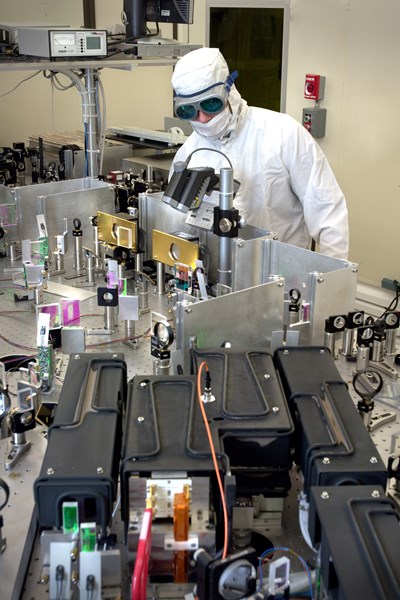REDONDO BEACH, Calif., Nov. 9, 2005 (PRIMEZONE) -- A high-energy, solid-state laser developed by Northrop Grumman Corporation (NYSE:NOC) for the U.S. military has fired one of the most powerful beams yet produced by an electric laser of more than 27 kW with a run time of 350 seconds.
In posting those achievements, the company said it surpassed the power and run time requirements of the Joint High Power Solid-State Laser (JHPSSL) Phase 2 demonstration program, a military effort to leap frog speed-of-light technology.
In a separate test, the laser demonstrated excellent beam quality at 19 kW, showing how well the beam can be focused and thus get to a target. The JHPSSL program was funded by the U.S. Air Force Research Laboratory, Kirtland Air Force Base, N.M., and the Office of the Secretary of Defense - Joint Technology Office, Albuquerque.
"The solid-state technology we've demonstrated will serve as the architectural foundation for a whole class of lasers that could be applied throughout much of the U.S. military," said Alexis Livanos, president of Northrop Grumman's Space Technology sector. Potential uses include protective and strike capabilities for ships, manned and unmanned aircraft, and ground vehicles.
"To our knowledge, these achievements make the Northrop Grumman laser the brightest, continuously operating, solid-state laser demonstrated to date," Livanos added.
"Solid-state lasers will add new force protection and joint warfighting capabilities across military services," said Art Stephenson, vice president of Directed Energy Systems at Northrop Grumman Space Technology. "In addition to the JHPSSL success, Northrop Grumman has been leading the development and demonstration of complete laser systems. During the past five years, through the Tactical High Energy Laser program executed in conjunction with the U.S. Army, we've shown the effectiveness of a high-power laser system against a variety of in-flight rockets, artillery and mortars.
"We have also shown that the lethality of a laser results from much more than just the power level. The laser must have good beam quality and a long run time, which are proven hallmarks of our systems. Our solid-state laser approach has been shown to be 'scaleable' to high-power levels without stressing the components. That's why we believe it's time to take high-energy lasers out of the lab and begin integrating them onto the battlefield."
Stephenson noted that Northrop Grumman's low-power, solid-state lasers are being used daily by the U.S. military for target designation and range finding. In addition, a Northrop Grumman solid-state illuminator laser, the Beacon Illuminator Laser - the most powerful solid-state laser on the Airborne Laser (ABL) - is being used for ground testing now. The company is also under contract to build a more capable follow-on illuminator, the Strategic Illuminator Laser, which is only a few years away, he added. Northrop Grumman built the megawatt-class laser for ABL, the Chemical Oxygen Iodine Laser.
Northrop Grumman Space Technology, based in Redondo Beach, Calif., has been developing and demonstrating high-energy lasers for more than 30 years. Space Technology develops a broad range of systems at the leading edge of space, defense and electronics technology. The sector creates products for U.S. military and civilian customers that contribute significantly to the nation's security and leadership in science and technology.
Northrop Grumman JHPSSL Fact Sheet Follows
Fact Sheet
Joint High Power Solid State Program, Phase 2
Northrop Grumman Space Technology
Technical Achievements
----------------------------------------------------------------------
JHPSSL Goals Northrop Grumman Achievement
----------------------------------------------------------------------
Power Level - 25 kW Reached 27 kW, operating in steady
state (continuous wave)
Significance: This was one of the most
powerful light beams ever fired from a
solid-state laser.
----------------------------------------------------------------------
Run Time - 300 seconds 350 seconds duration
Significance: The company's laser
demonstrator could have operated
much longer. `Run time' measures
how long the laser can fire. More
time on target increases lethality
substantially - and allows more
laser `shots' per magazine.
----------------------------------------------------------------------
Beam Quality - 1.5 Demonstrated excellent beam quality
of "2" (or two times the diffraction
limit) at 19 kW power level and run
time of 350 seconds
Significance: Beam quality refers
to how well the beam can be focused
and thus get to a target. A perfect
laser beam has a beam quality of
"1." By comparison, a typical
industrial laser for welding would
have a beam quality exceeding "20."
----------------------------------------------------------------------
Northrop Grumman's Design
Northrop Grumman's approach utilizes amplifier chains assembled with multiple high-power gain modules. The company's JHPSSL demonstrator used two chains to demonstrate the 27 kW level. The company's scaleable approach can achieve higher power by adding more chains.
Background
The JHPSSL program began in December 2002 by the U.S military to accelerate solid-state laser technology for military uses. Solid-state lasers offer the potential of being compact and suitable to a wide range of applications and platforms.
JHPSSL Phase 1 addressed risk reduction of the technologies necessary to obtain high- power and beam quality simultaneously.
Phase 2 took these technologies and scaled them to greater than 25 kW, and showed further scalability to 100 kW and beyond.
